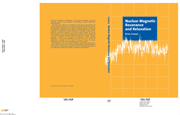Book contents
- Frontmatter
- Contents
- Preface
- 1 Introduction
- 2 Theoretical background
- 3 Detection methods
- 4 Classical view of relaxation
- 5 Quantum treatment of relaxation
- 6 Dipolar lineshape in solids
- 7 Relaxation in liquids
- 8 Some case studies
- 9 The density operator and applications
- 10 NMR imaging
- Appendix A Fourier analysis
- Appendix B Random functions
- Appendix C Interaction picture
- Appendix D Magnetic fields and canonical momentum
- Appendix E Alternative classical treatment of relaxation
- Appendix F Gm(t) for rotationally invariant systems
- Appendix G P(Ω, Ωo, t) for rotational diffusion
- Problems
- References
- Index
10 - NMR imaging
Published online by Cambridge University Press: 02 December 2009
- Frontmatter
- Contents
- Preface
- 1 Introduction
- 2 Theoretical background
- 3 Detection methods
- 4 Classical view of relaxation
- 5 Quantum treatment of relaxation
- 6 Dipolar lineshape in solids
- 7 Relaxation in liquids
- 8 Some case studies
- 9 The density operator and applications
- 10 NMR imaging
- Appendix A Fourier analysis
- Appendix B Random functions
- Appendix C Interaction picture
- Appendix D Magnetic fields and canonical momentum
- Appendix E Alternative classical treatment of relaxation
- Appendix F Gm(t) for rotationally invariant systems
- Appendix G P(Ω, Ωo, t) for rotational diffusion
- Problems
- References
- Index
Summary
Basic principles
Spatial encoding
Since the NMR resonance frequency of a spin is proportional to the magnetic field it experiences, it follows that in a spatially varying field spins at different positions will resonate at different frequencies. The spectrum from such a system will give an indication of the number of spins experiencing the different fields.
In a uniform magnetic field gradient the precession frequency is directly proportional to displacement in the direction of the gradient; there is a direct linear mapping from the spatial co-ordinates to frequency. Thus the absorption spectrum yields the number of spins in ‘slices’ perpendicular to the gradient. In Figure 10.1 we show how the spectrum would be built up from such slices.
We have already encountered the concept of spatial encoding of spins in Section 4.5 where we considered diffusion and the way it can be measured using spin echoes. There the important point was that whereas spins in a field gradient with their corresponding spread of precession frequencies suffer a decay of transverse magnetisation, this can be recovered, to a large extent, by the time-reversing effect of a 180° pulse. However, if the particles are defusing then, because of the field gradient, their motion will take them to regions of differing precession frequencies. The resultant additional dephasing cannot be recovered by a 180° pulse, which thus permits the diffusion coefficient to be measured.
In imaging one is concerned with the main dephasing effect of the gradient field. Compared with this the diffusive effects are small, and in our initial treatment we shall assume that the resonating spins are immobile.
- Type
- Chapter
- Information
- Nuclear Magnetic Resonance and Relaxation , pp. 335 - 361Publisher: Cambridge University PressPrint publication year: 1997

